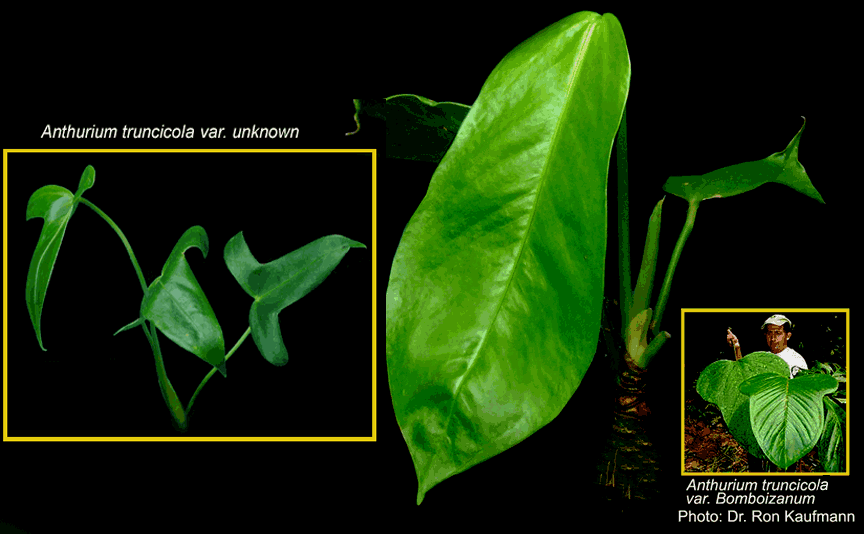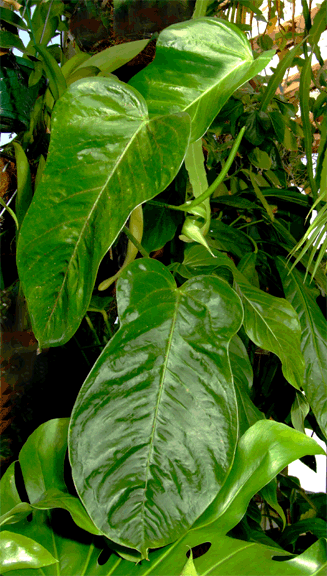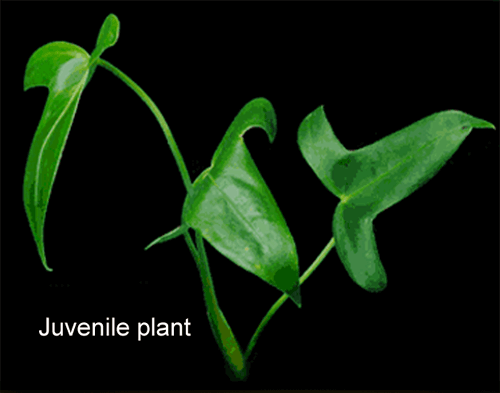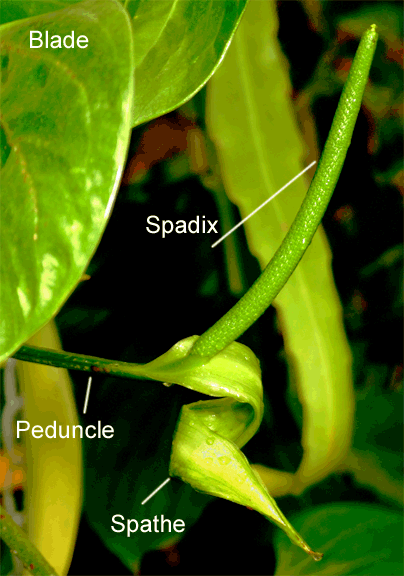![]()
Aroids and other genera in the Collection
Take the Tour Now?
Orchids
The
Exotic Rainforest
Plants in
the Exotic Rainforest Collection
The images on this website are copyright protected. Please contact us before any reuse.
Detailed information on Growing Anthurium
Species Click this Link
Within our collection we have many species of Anthurium. If you are seeking other photos, click this link:

Anthurium
truncicola
Engler
Sometimes found as Anthurium truncicolum
Synonyms:
Anthurium alatum Engl., Anthurium divaricatum Sodiro,
Anthurium marginatum Sodiro, Anthurium martinezii Sodiro,
Anthurium platyglossum Sodiro, Anthurium platyglossum var nanegalense Sodiro,
Anthurium platylobum Sodiro, Anthurium subdeltoideum Engl.,
Anthurium tridigitatum Engl.
and others
Sometimes found as Anthurium truncicolum
Synonyms:
Anthurium alatum Engl., Anthurium divaricatum Sodiro,
Anthurium marginatum Sodiro, Anthurium martinezii Sodiro,
Anthurium platyglossum Sodiro, Anthurium platyglossum var nanegalense Sodiro,
Anthurium platylobum Sodiro, Anthurium subdeltoideum Engl.,
Anthurium tridigitatum Engl.
and others
Important note:
Anthurium
species are known to be highly variable and not every leaf of every
specimen will always appear the same. This link explains in
non-scientific words the facts of natural variation and
morphogenesis. Understanding natural variation within a species
will be important to understanding this species Please read this
link once you read this page:
Click here.
Plants can easily fool you! I read the disagreements of plant
collector "experts" all the time who swear some plant "just isn't" what
someone else thinks it to be. As a result I would strongly
recommend anyone interested in variable species, a feature common within
aroid species (Araceae) read this brief explanation of natural variation
within species before proceeding.
Click this link
In September of 2005 I received several rare
Anthurium specimens from a rare plant grower in Ecuador known as
 Ecuagenera. I was
hoping to get one particularly unusual tri-lobed Anthurium known as
Anthurium Code 21 which I had
never seen in any collection. The plant I wanted was "dog-eared", a
larger lobe in the center with two smaller lobes hanging like dog ears
on either side. I received a plant which had no leaves, (not uncommon)
and no tag, which was otherwise healthy. It took months for the plant
to begin to put on new foliage and when it did it was apparent, or so
I thought, the plant was not the tri-lobed species I had hoped to
receive. Several months passed before I began to exchange email
with Dr. Ron Kaufmann in southern California. Dr. Kaufmann is not
a botanist, he has a PhD in Marine Science, but is still a very qualified
plant expert. He asked me to send a photo of the plant and he
would attempt
to help me find a scientific name for the species. With his assistance, and the input
of United State's best known aroid botanist Dr. Tom Croat of the Missouri Botanical Gardens,
that plant was identified as Anthurium truncicola. I would
soon learn Anthurium truncicola was in fact the scientific
name for the specimen sometimes known as Code 21 and in some cases as Anthurium truncicolum
although the spelling is not scientifally accurate.
Ecuagenera. I was
hoping to get one particularly unusual tri-lobed Anthurium known as
Anthurium Code 21 which I had
never seen in any collection. The plant I wanted was "dog-eared", a
larger lobe in the center with two smaller lobes hanging like dog ears
on either side. I received a plant which had no leaves, (not uncommon)
and no tag, which was otherwise healthy. It took months for the plant
to begin to put on new foliage and when it did it was apparent, or so
I thought, the plant was not the tri-lobed species I had hoped to
receive. Several months passed before I began to exchange email
with Dr. Ron Kaufmann in southern California. Dr. Kaufmann is not
a botanist, he has a PhD in Marine Science, but is still a very qualified
plant expert. He asked me to send a photo of the plant and he
would attempt
to help me find a scientific name for the species. With his assistance, and the input
of United State's best known aroid botanist Dr. Tom Croat of the Missouri Botanical Gardens,
that plant was identified as Anthurium truncicola. I would
soon learn Anthurium truncicola was in fact the scientific
name for the specimen sometimes known as Code 21 and in some cases as Anthurium truncicolum
although the spelling is not scientifally accurate.
 Ecuagenera. I was
hoping to get one particularly unusual tri-lobed Anthurium known as
Anthurium Code 21 which I had
never seen in any collection. The plant I wanted was "dog-eared", a
larger lobe in the center with two smaller lobes hanging like dog ears
on either side. I received a plant which had no leaves, (not uncommon)
and no tag, which was otherwise healthy. It took months for the plant
to begin to put on new foliage and when it did it was apparent, or so
I thought, the plant was not the tri-lobed species I had hoped to
receive. Several months passed before I began to exchange email
with Dr. Ron Kaufmann in southern California. Dr. Kaufmann is not
a botanist, he has a PhD in Marine Science, but is still a very qualified
plant expert. He asked me to send a photo of the plant and he
would attempt
to help me find a scientific name for the species. With his assistance, and the input
of United State's best known aroid botanist Dr. Tom Croat of the Missouri Botanical Gardens,
that plant was identified as Anthurium truncicola. I would
soon learn Anthurium truncicola was in fact the scientific
name for the specimen sometimes known as Code 21 and in some cases as Anthurium truncicolum
although the spelling is not scientifally accurate.
Ecuagenera. I was
hoping to get one particularly unusual tri-lobed Anthurium known as
Anthurium Code 21 which I had
never seen in any collection. The plant I wanted was "dog-eared", a
larger lobe in the center with two smaller lobes hanging like dog ears
on either side. I received a plant which had no leaves, (not uncommon)
and no tag, which was otherwise healthy. It took months for the plant
to begin to put on new foliage and when it did it was apparent, or so
I thought, the plant was not the tri-lobed species I had hoped to
receive. Several months passed before I began to exchange email
with Dr. Ron Kaufmann in southern California. Dr. Kaufmann is not
a botanist, he has a PhD in Marine Science, but is still a very qualified
plant expert. He asked me to send a photo of the plant and he
would attempt
to help me find a scientific name for the species. With his assistance, and the input
of United State's best known aroid botanist Dr. Tom Croat of the Missouri Botanical Gardens,
that plant was identified as Anthurium truncicola. I would
soon learn Anthurium truncicola was in fact the scientific
name for the specimen sometimes known as Code 21 and in some cases as Anthurium truncicolum
although the spelling is not scientifally accurate.
I asked my friend Elizabeth Campbell who lives in
Ecuador to explain the meaning of the Latin words that are the roots of
these scientific names. Beth wrote
"Truncicola" is a plural, while the
second name Truncicolum is singular. The roots from which this one
is derived are Truncata, which means ''mutilated'' or ''missing'' and
Colum, which means ''cultivated'' but has the secondary meaning of
''tail'' which I personally think is more likely given the shape of the
juvenile leaves (ie missing their posterior lobes, or their tails."
The plant I had received did not have the shape of the Code 21 I had
expected because it is a variation of Anthurium truncicola known
at present as
Anthurium truncicola var. bomboizanum.
Dr. Croat is currently working on a
similar
specimen with the possible new scientific name of
Anthurium bomboizense Croat or
Anthurium bomboizoanum Croat. As
yet, the newest name is unpublished and until further research is
complete, publication is unsure. The name was derived since the
variation was found near the
town of Bomboiza which is in the Zamora-Chichipe portion of Ecuador.
In an email received in mid January, 2008, Dr. Croat indicated, "What I call A. bomboizoanum (or A.
truncicolum var. bomboizoanum) is known principally from the area around
Bomboiza, and other areas in the Cordillera del Condor. It also occurs
very near El Pangui. It is most likely that your plant came from
near El Pangui." Ecuador has Provinces rather than states
The Province of Zamora has undergone a name-change and is now the
Province of Zamora-Chinchipe.
It appears that if you grow this plant you also need to possess some knowledge of botany to identify and understand all the species natural variations since Anthurium truncicola has
numerous variations! There are 15 known synonyms (same plant, other name) for this
species due to the varied forms, A. truncicola has been apparently fooling botanical
experts for many years! All of those 15 named plants are in fact one
species! They just have very varied growth forms. Think of
it as people being tall, skinny, obese, short and with different skin
colorations. All one species, just variations of that single
species. In this case, so varied the aroids
appear to be entirely different plant species! And size is of no
relevance. This quote can be found within the paper quoted at the
beginning of this article, "Size
of any morphological structure in Anthurium is highly variable because
plants often change remarkably in size over the course of their lives
and also in response to the general climatic conditions where they
occur, particularly in geographically widespread species. Habit,
Stem, and Cataphylls"
the species natural variations since Anthurium truncicola has
numerous variations! There are 15 known synonyms (same plant, other name) for this
species due to the varied forms, A. truncicola has been apparently fooling botanical
experts for many years! All of those 15 named plants are in fact one
species! They just have very varied growth forms. Think of
it as people being tall, skinny, obese, short and with different skin
colorations. All one species, just variations of that single
species. In this case, so varied the aroids
appear to be entirely different plant species! And size is of no
relevance. This quote can be found within the paper quoted at the
beginning of this article, "Size
of any morphological structure in Anthurium is highly variable because
plants often change remarkably in size over the course of their lives
and also in response to the general climatic conditions where they
occur, particularly in geographically widespread species. Habit,
Stem, and Cataphylls"
It appears that if you grow this plant you also need to possess some knowledge of botany to identify and understand all
 the species natural variations since Anthurium truncicola has
numerous variations! There are 15 known synonyms (same plant, other name) for this
species due to the varied forms, A. truncicola has been apparently fooling botanical
experts for many years! All of those 15 named plants are in fact one
species! They just have very varied growth forms. Think of
it as people being tall, skinny, obese, short and with different skin
colorations. All one species, just variations of that single
species. In this case, so varied the aroids
appear to be entirely different plant species! And size is of no
relevance. This quote can be found within the paper quoted at the
beginning of this article, "Size
of any morphological structure in Anthurium is highly variable because
plants often change remarkably in size over the course of their lives
and also in response to the general climatic conditions where they
occur, particularly in geographically widespread species. Habit,
Stem, and Cataphylls"
the species natural variations since Anthurium truncicola has
numerous variations! There are 15 known synonyms (same plant, other name) for this
species due to the varied forms, A. truncicola has been apparently fooling botanical
experts for many years! All of those 15 named plants are in fact one
species! They just have very varied growth forms. Think of
it as people being tall, skinny, obese, short and with different skin
colorations. All one species, just variations of that single
species. In this case, so varied the aroids
appear to be entirely different plant species! And size is of no
relevance. This quote can be found within the paper quoted at the
beginning of this article, "Size
of any morphological structure in Anthurium is highly variable because
plants often change remarkably in size over the course of their lives
and also in response to the general climatic conditions where they
occur, particularly in geographically widespread species. Habit,
Stem, and Cataphylls"
Anthurium truncicola is a member of
Anthurium section Semaeophyllium. Section Semaeophyllium
contains 23 species according to Dr. Croat's and Monica Carlsen's
Taxonomic Revision of the Section Semaeophyllium on Anthurium species,
all within that section possessing deeply tri-lobed leaf
blades. Anthurium section Semaeophyllium is now known to represent the largest
group of Anthurium species with lobed leaves
and is also known to contain numerous taxonomic complications which are
currently being resolved. Monica Carlsen is a student PhD
candidate of Dr.
Thomas B. Croat
Ph.D., P.A.
Schulze Curator of Botany
of the Missouri Botanical
Garden in St. Louis, MO. Dr. Croat is known to be the world's
leading authority in aroid species, especially of the genus Anthurium,
and is the personal mentor and
chief consultant to this author in to present scientifically
accurate facts regarding a variety of aroid species. This specific
group of species has been discussed privately in his person offices on
more than one occasion. Although I make no personal claim to any
form of expertise in the subject, the material presented was taken
directly from the journals quoted. Although Dr. Croat now states
there are just less than 1000 Anthurium species, all variable, less than
9% of the entire genus contains lobed leaves.
According to the paper by Monica Dr.
Croat, Anthurium truncicola is
sometimes thought to be similar to A. cundinamarcense bit is not
recognized as synonym of Anthurium truncicola. Instead, Dr. Croat and Monica
believe that a specimen known as Lehmann 7352 is a mixed collection that
includes both a specimen of Anthurium truncicola and a specimen that agrees
with the original description of A. cundinamarcense. The latter species
is currently accepted as a synonym of A. nigrescens and differs from A.
truncicola by having cordate instead of tri-lobed leaves. Anthurium nigrescens is currently placed in section Cardiolonchium.
Anthurium truncicola may be confused with Anthurium grex-avium as well as Anthurium platyglossum, since all are climbing species with similar characteristics. However, careful examination of features such as the internodes as wel as the lateral lobes reveal distinct differences.
Anthurium truncicola may be confused with Anthurium grex-avium as well as Anthurium platyglossum, since all are climbing species with similar characteristics. However, careful examination of features such as the internodes as wel as the lateral lobes reveal distinct differences.
When grown my new plant with its thick
coriaceous (leathery) leaves will develop the three lobes I expected but in a totally
different shape. Now, December,
2006, the largest leaf measures 40cm (16
inches) by 16cm (6 1/2 inches) wide. When
 fully grown var. bomboizana
will be shaped more like a very fat letter "T" with the lower lobe quite
wide
while the upper lobes are growing straight out to the left and
right at the top yet smaller in size. Dr. Kaufmann has provided a
dramatic photo showing the species' variation
bomboizanum I received which is included above. Variation bomboizanum
shows only a
single blade in its present juvenile form with over
one year of growth. The specimen can become even more spectacular,
especially in size, than the specimen I had originally hoped to acquire
with leaves well over 60cm (2 feet) wide.
fully grown var. bomboizana
will be shaped more like a very fat letter "T" with the lower lobe quite
wide
while the upper lobes are growing straight out to the left and
right at the top yet smaller in size. Dr. Kaufmann has provided a
dramatic photo showing the species' variation
bomboizanum I received which is included above. Variation bomboizanum
shows only a
single blade in its present juvenile form with over
one year of growth. The specimen can become even more spectacular,
especially in size, than the specimen I had originally hoped to acquire
with leaves well over 60cm (2 feet) wide.
 fully grown var. bomboizana
will be shaped more like a very fat letter "T" with the lower lobe quite
wide
while the upper lobes are growing straight out to the left and
right at the top yet smaller in size. Dr. Kaufmann has provided a
dramatic photo showing the species' variation
bomboizanum I received which is included above. Variation bomboizanum
shows only a
single blade in its present juvenile form with over
one year of growth. The specimen can become even more spectacular,
especially in size, than the specimen I had originally hoped to acquire
with leaves well over 60cm (2 feet) wide.
fully grown var. bomboizana
will be shaped more like a very fat letter "T" with the lower lobe quite
wide
while the upper lobes are growing straight out to the left and
right at the top yet smaller in size. Dr. Kaufmann has provided a
dramatic photo showing the species' variation
bomboizanum I received which is included above. Variation bomboizanum
shows only a
single blade in its present juvenile form with over
one year of growth. The specimen can become even more spectacular,
especially in size, than the specimen I had originally hoped to acquire
with leaves well over 60cm (2 feet) wide.
Anthurium differ from
Philodendron species since all Anthurium produce perfect
flowers containing both male and female organs while Philodendron
produce imperfect flowers containing only a single sex. At
sexual anthesis all Anthurium produce an inflorescence which
contains both a spathe and a spadix. The spadix is only a modified
leaf and not a flower which surrounds the fleshy spike known as the
spadix. When an
Anthurium is "in flower" the reference is to the tiny flowers
containing both male and female sexual parts that grow on the spadix at
the center of the inflorescence. To help prevent self pollination nature has
designed the female flowers to be receptive before the male portion of
the flower
produce their pollen so in most cases an insect must bring pollen from
another plant.
In
January, 2008 the var. Bombiozanum produced a spathe and spadix.
The spathe measured 16cm (16.5") when fully unfurled while the
spadix measured 14cm (5.5 inches). As you can see in the photo
(left) the spathe was curled like a "pig-tail". According to
aroid botanist Dr. Tom Croat, this type of curled spathe is known as
linear-lanceolate, reflexed-spreading and longitudinally coiled to one
side.
With Dr. Kaufmann's assistance I have also managed to locate a specimen
of the plant I had originally hoped to find (see inset left above as
well as on this page). That one
is still small with leaf blades approximately 15cm (6 inches). The
smaller specimen has yet to fully develop the dog-eared form but is just
now beginning to develop that characteristic.
Found in the Andes Mountains of Ecuador, Anthurium truncicola grows in the Pichincha region rainforests of Nanegal and Mindo. Dr. Kaufmann's photo was taken in the state of Zamora, Ecuador. The species enjoys high humidity, medium light and well draining soil. Anthurium truncicola is a climber, and is also a prize in any collection!
Found in the Andes Mountains of Ecuador, Anthurium truncicola grows in the Pichincha region rainforests of Nanegal and Mindo. Dr. Kaufmann's photo was taken in the state of Zamora, Ecuador. The species enjoys high humidity, medium light and well draining soil. Anthurium truncicola is a climber, and is also a prize in any collection!
Join the
International Aroid Society:
http://www.exoticrainforest.com/Join%20IAS.html
If you are seeking
information on other rare species, click on "Aroids and other genera in the Collection"
at the top and look for the